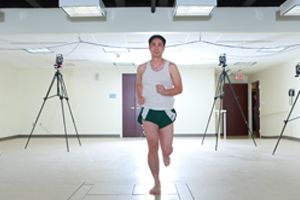Research Spotlight: The Gait Lab
February 28, 2014
 Tucked away on the second floor of the College of Nursing and Health Professions’ Three Parkway facilities is the newly developed Gait Lab of the Department of Physical Therapy and Rehabilitation Sciences. Just installed in September, the lab allows researchers to look at different kinds of body locomotion with an eight camera system and four plates in the floor. Together, they measure a subject’s torque, force, and movement.
Tucked away on the second floor of the College of Nursing and Health Professions’ Three Parkway facilities is the newly developed Gait Lab of the Department of Physical Therapy and Rehabilitation Sciences. Just installed in September, the lab allows researchers to look at different kinds of body locomotion with an eight camera system and four plates in the floor. Together, they measure a subject’s torque, force, and movement.
Similar to the systems used to project real movements of people in video games like Tiger Woods Golf, the Gait Lab uses 12 millimeter and 6 millimeter tracker balls attached to the research subject to track their movements. Over 50 markers are used on a typical subject. The force plates in the ground are akin to stepping on a bathroom scale; the subjects walk or run over the plates and the force is recorded. All of the measurements are analyzed through varying computer software and are studied by Clare Milner, PhD, an associate professor in the Physical Therapy and Rehabilitation Sciences Department, and her PhD student, Trey Brindle.
One of the major areas of research for Milner and Brindle is overuse running injuries. “It’s very common in running. You take thousands and thousands of steps. For every mile you take about 1500 steps. Multiply that by 3 miles a day for 4 times a week. It’s a lot of repetition,” Milner said.
“[Overuse injuries] start as a little niggle and you keep going and it gets a little more painful and eventually it’s causing you to have to restrict your running and you’ll want to get some kind of treatment to fix that injury,” she continued.
Milner hopes to work with patients from Robert Maschi, DPT’s running clinic to study their running movement patterns and the injuries they may be getting.
“The movement pattern as you run is recognized as a contributing factor in overuse injuries. If you can understand that and how [overuse injuries are] happening, and see how someone’s moving slightly differently, perhaps you can take that information and go back and try to figure out either how to prevent that injury from happening,” Milner said.
Brindle is using the Gait Lab to study the differing ways in which healthy male and female runners run, specifically looking at aspects related to injury. Male runners have certain types of injuries that female runners do not get as often and vice versa. He wants to see what differences relating to those injuries may appear between genders. Brindle is also researching plantar fasciitis, a musculoskeletal injury common in runners. He’s comparing subjects with Plantar Fasciitis to healthy runners by looking at the differences in the lower extremities and joint angles during running.
Another large area of research Milner is focusing on is how the quality of walking in adults is affected by knee arthritis and/or knee replacement.
“It’s painful to have knee arthritis and naturally people become less active. After the surgery and rehabilitation, the knee has less pain but many people still maintain the same habits when they had a lot of pain,” Milner said.
Research will be done to compare how adults with knee arthritis or a knee replacement walk versus how they use their knee in common recreational activities. Activities like bowling and golf are popular with older adults, but may be demanding for the knee. The goal is to find ways for people with knee arthritis and knee replacement to maintain higher activity levels, which will help them to be healthy.